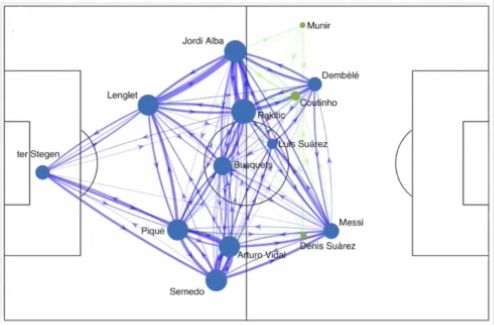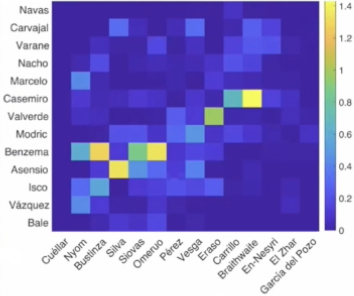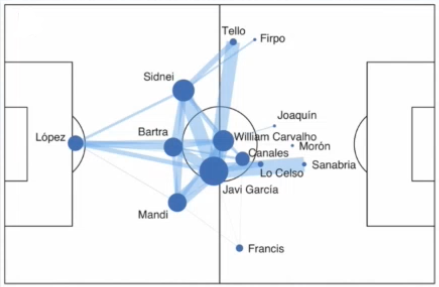Javier Martin Buldu is an expert on the analysis of non-linear systems and the understanding of how complex systems organise themselves, adapt and evolve. He focuses on the application of network science and complex systems theory in the analysis of sports. Buldu’s work is based on the principle that teams are far more than the simple aggregation of their individual players. By collaborating with organisations such as the Centre of Biomedical Technology in Madrid, La Liga, ESADE Business School, IFISC research institute and the ARAID Foundation, he has been able to combine elements of graph theory, non-linear dynamics, statistical physics, big data and neuroscience to construct various networks using positional tracking data of a football match. These networks are then able to explain what happens on the pitch beyond conventional ways of assessing the performance of individual players to understand team behaviours.
What Is Complex System Theory?
A complex system is a system composed by different parts that are connected and interact with one another. This system has properties and behaviours that cannot be explained by simply breaking down the system into its individual parts and analysing each individual part independently. For example, the human brain is a complex system and it has proven extremely challenging for scientists to fully understand how it performs all its functions, from how memory is stored to how cognition appears and disappears during certain illnesses. On the other hand, the human brain’s most fundamental component, the neuron, has been thoroughly studied and documented by science. Scientists have been able to recreate models and simulations of neuron behaviour, understand their shape and how they communicate with other neurons. However, this robust understanding of single neuron behaviour has not been sufficient to allow scientist to comprehend the interplay and interdependencies of the 80 billions neurons that form the human brain and that allows it to perform all of its complex behaviours. Instead, in order to appropriately study the brain, scientist need to pay attention to entire human cognitive system as a whole.
The idea behind complex systems like the human brain is what Buldu wanted to introduce in the analysis of football. While it is interesting to have information about isolated player performance, such as the number of shots, passes or successful dribbles, it is also important to understand the context in which these events take place. Additional insights on the performance of players and teams can be obtained by analysing information about how a player interacted with his teammates and the opposition’s players. Paying attention to individual player performances and aggregating those together is not enough to fully understand how a team behaves during a match.
Instead, a complex system approach to football analysis would, for example, look at the link created between two or more players when they pass the ball between them. A network of these players can then be created by simply leveraging event data collected from notational video analysis to count the number of passes from player A to player B and vice versa. These types of passing networks are increasingly common in football match analysis and team reports, as they clearly illustrate information about how a team played during a match, where its players were most frequently located on the pitch and how they interacted with each other.
Passing Network between FC Barcelona players (Source: Javier Martin Buldu at FC Barcelona Sports Tomorrow)
However, more complex and informative networks can be developed by leveraging positional tracking data instead of event data. While event data is generated through notational analysis by tagging specific actions, positional tracking data instead describes the position of the 22 players and the ball on the pitch at any moment in time during a match of football. Unfortunately, positional tracking data is challenging to access for most analysts. That is why Buldu collaborated with La Liga to obtain a positional tracking dataset containing Spanish football league matches. To capture this information, La Liga uses Mediacoach, a software that acquires the positional coordinates of players and the ball using a TRACAB optical video tracking system that requires the installations of specialised cameras across the football stadiums. Mediacoach’s system allows them to track a player’s position at 25 frames per second and a precision of 10cm. Thanks to this detailed tracking dataset received from La Liga, Buldu was able to explore the different interactions between players to construct a number of complex tracking networks in football.
Proximity Networks
The first network that Buldu produced explored the proximity between players on the pitch. He first calculated an arbitrary 360 degrees distance around a player, let’s say a 5m radius, and used it as a threshold to identify any other players that may fall inside that particular player’s area. If another player was located inside of the first player’s surrounding area, a link was then created between those two players. If those two players were from the same team, a positive link was created, while if they were from opposing teams a negative link was assigned to that interaction instead. By increasing or decreasing the radius of the distance surrounding each player (i.e. 5m, 10m or 15m radius), Buldu produced different networks and links between players following this method.
Proximity radius at 5m, 10m and 15m showing links with players of the same team (green) and with opposing players (red) (Source: Javier Martin Buldu at FC Barcelona Sports Tomorrow)
The challenge of producing a variety of proximity networks is that they may prove difficult to analyse, as the links identified in a single video frame using a 5m radius around each player may be very different to those found using a 15m radius. On top of that, the analysis should look at how those proximity networks evolve over a number of frames during the match. In order to gather practical insights from these networks, Buldu aimed to study the number of positive and negative links for each of the teams, as well as the organisation of the proximity network structure, its temporal evolution and how they change in relation to the zone of the pitch and the various phases of the game.
Proximity analysis of the 3-player links for all players in a match between Atletico Madrid and Real Valladolid (Source: Javier Martin Buldu at FC Barcelona Sports Tomorrow)
He first counted the number of links between three different players forming a triangle. He then classified each triangle into two categories: positive (all players from the same team) or mixed triangles (at least one player from the opposing team). Buldu was then able to determine which team had dominance over the other at different times of the match by then counting the number of positive triangles and the number of mixed triangles produced with a certain threshold distance. The team with the the highest proportion of positive triangles (i.e. all three players in close proximity to each other forming a triangle were from the same team) was deemed to have been dominant over its opposition.
Marking Networks
The second type of network that Buldu was able to construct with positional tracking data was the time a player was covering an opposing player during a defensive phase of play. Again, by setting an arbitrary threshold distance around a defender, a link between the defender and opposing player can be set by counting the time both players are in close proximity to one another. This process produces a matrix that illustrates the defenders on one of the axis and the attackers on the other axis, and provides a rough idea about the amount of time that each attacking player was being marked and by which defensive player. By interpreting the marking matrix analysts are able to identify the players with the highest accumulated time being marked by a defensive player.
Player marking matrix between Real Madrid (y-axis) and Leganes (x-axis) showing how often each Real Madrid players was marked by a Leganes player (Source: Javier Martin Buldu at FC Barcelona Sports Tomorrow)
Since matrices are the mathematical extraction of a network, this information can be drawn onto a diagram of a football pitch to plot the position of players during defensive actions. The size of each node in this network indicates the time an attacking player was being defended. By using these marking networks, analysts can clearly visualise the interactions and efforts of attacking and defending players during a match of football.
Player marking network between Real Madrid and Leganes (Source: Javier Martin Buldu at FC Barcelona Sports Tomorrow)
Coordination Networks
The third network that Buldu produced evaluated the coordination of movements between players of the same team. The network computed the velocity and direction of movement of two players to measure the alignment of their vectors. When this vector alignment was high, a high value link between these two players was created. When the alignment was low, a lower value connection was also derived from the two players’ movements. This method results in a matrix that illustrates how well players are coordinated with their own teammates. Two different matrices can be produced, one to analyse offensive phases of play and one for defensive phases.
Vector alignment of two attacking players (Source: Javier Martin Buldu at FC Barcelona Sports Tomorrow)
Similarly to marking networks, coordination network matrices can also be translated into diagrams on a football pitch, where the nodes represent each player on the pitch while the size of each node indicates the amount of coordination the player has with the rest of his teammates. The links between two nodes also indicate the level of coordination between two particular players of the same team.
Movement coordination of each player with the rest of his teammates (Source: Javier Martin Buldu at FC Barcelona Sports Tomorrow)
This type of analysis, especially when split between offensive and defensive players, can help analysts better understand the level of coordination between attack and defensive plays. For instance, an analyst or coach may want to see high degrees of coordination when the team defends as a block as well as how that coordination changes during the different phases of the game.
Ball Flow Networks
Lastly, the final network developed by Buldu focused on ball movement between different areas of the pitch. This network was produced by splitting the football pitch into different sections and counting the number of times the ball travelled from one section to another in order to create links between two different sections. This ball flow network can also be visualised on a diagram of a football pitch, with the nodes representing each section of the pitch and links indicating the number of times the ball moved from one section to the next. The size of these nodes indicate the amount of time the ball was being played inside that particular section of the pitch. By constructing an entire ball moving network during a match, analysts can then identify which are the most important sections of the pitch for their teams and assess how to exploit different sections in the opposition’s side in order to create dangerous opportunities.
Ball flow network for a match between FC Barcelona and Espanyol (Source: Javier Martin Buldu at FC Barcelona Sports Tomorrow)
Buldu’s work provides a great analytical framework to assess the complexities of sports in which a large diversity of factors can influence different outcomes of the game. It is crucial that when analysing a sport, all the available contextual information is analysed from various perspectives that can together provide a more complete evaluation of performance. Researchers, scientists and analysts are increasingly producing exciting work with positional tracking data that can open the door to new sophisticated methodologies and models to help coaches better understand the key influential factors of their team’s performance.
Further Reading:
Buldu, J. M., Busquets, J., & Echegoyen, I. (2019). Defining a historic football team: Using Network Science to analyze Guardiola’s FC Barcelona. Scientific reports, 9(1), 1-14. Link to article.
Buldu, J. M., Busquets, J., Martínez, J. H., Herrera-Diestra, J. L., Echegoyen, I., Galeano, J., & Luque, J. (2018). Using network science to analyse football passing networks: Dynamics, space, time, and the multilayer nature of the game. Frontiers in psychology, 9, 1900. Link to article.
Garrido, D., Antequera, D. R., Busquets, J., Del Campo, R. L., Serra, R. R., Vielcazat, S. J., & Buldú, J. M. (2020). Consistency and identifiability of football teams: a network science perspective. Scientific reports, 10(1), 1-10. Link to article.
Herrera-Diestra, J. L., Echegoyen, I., Martínez, J. H., Garrido, D., Busquets, J., Io, F. S., & Buldú, J. M. (2020). Pitch networks reveal organizational and spatial patterns of Guardiola’s FC Barcelona. Chaos, Solitons & Fractals, 138, 109934. Link to article.
Martínez, J. H., Garrido, D., Herrera-Diestra, J. L., Busquets, J., Sevilla-Escoboza, R., & Buldú, J. M. (2020). Spatial and Temporal Entropies in the Spanish Football League: A Network Science Perspective. Entropy, 22(2), 172. Link to article.









